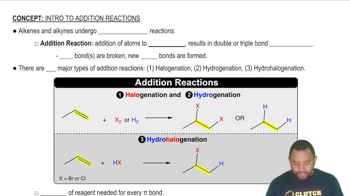This figure shows the interaction of a cation with surrounding water molecules. (b) Which of the following explanations accounts for the fact that the ion–solvent interaction is greater for Li+ than for K+? a. Li+ is of lower mass than K+. b. The ionization energy of Li is higher than that for K. c. Li+ has a smaller ionic radius than K+. d. Li has a lower density than K. e. Li reacts with water more slowly than K. [Section 13.1]
Ch.13 - Properties of Solutions
Chapter 13, Problem 5
The density of toluene (C7H8) is 0.867 g/mL, and the density of thiophene (C4H4S) is 1.065 g/mL. A solution is made by dissolving 8.10 g of thiophene in 250.0 mL of toluene. Assuming that the volumes of the solute and solvent are additive, what is the molarity of thiophene in the solution?
 Verified step by step guidance
Verified step by step guidance1
Calculate the volume of thiophene using its mass and density. Use the formula: \( \text{Volume} = \frac{\text{Mass}}{\text{Density}} \).
Determine the total volume of the solution by adding the volume of thiophene to the volume of toluene.
Calculate the number of moles of thiophene using its mass and molar mass. Use the formula: \( \text{Moles} = \frac{\text{Mass}}{\text{Molar Mass}} \).
Use the total volume of the solution (in liters) and the moles of thiophene to calculate the molarity. Use the formula: \( \text{Molarity} = \frac{\text{Moles of Solute}}{\text{Volume of Solution in Liters}} \).
Ensure all units are consistent, particularly converting mL to L for the volume of the solution.
Key Concepts
Here are the essential concepts you must grasp in order to answer the question correctly.
Density and Volume Relationships
Density is defined as mass per unit volume (g/mL). Understanding how to convert between mass and volume using density is crucial for solving problems involving solutions. In this case, the densities of toluene and thiophene allow us to determine the volume of thiophene when given its mass, which is essential for calculating molarity.
Recommended video:
Guided course

Relationship of Volume and Moles Example
Molarity
Molarity (M) is a measure of concentration defined as the number of moles of solute per liter of solution. To calculate molarity, one must first convert the mass of the solute (thiophene) into moles using its molar mass. The final step involves dividing the number of moles by the total volume of the solution in liters, which is critical for determining the concentration of thiophene in the solution.
Recommended video:
Guided course

Molarity
Additivity of Volumes
The assumption that the volumes of solute and solvent are additive simplifies the calculation of the total volume of the solution. This means that when thiophene is dissolved in toluene, the total volume can be approximated by simply adding the volume of toluene to the volume of thiophene. This concept is important for accurately determining the final volume used in the molarity calculation.
Recommended video:
Guided course

Addition Reactions
Related Practice
Textbook Question
Textbook Question
Consider two ionic solids, both composed of singly charged ions, that have different lattice energies. (a) Will the solids have the same solubility in water? (b) If not, which solid will be more soluble in water, the one with the larger lattice energy or the one with the smaller lattice energy? Assume that solute–solvent interactions are the same for both solids. [Section 13.1]
3
views
Textbook Question
The structures of vitamins E and B6 are shown below. Predict which is more water soluble and which is more fat soluble. [Section 13.3]
